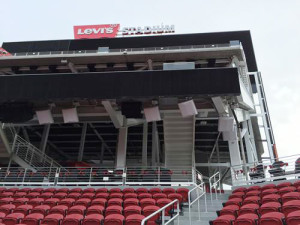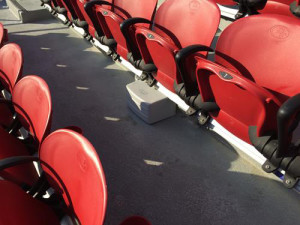How DGP Delivered 2x the Traffic at 3x the Speeds During Super Bowl 50
It’s been established that Levi’s Stadium has taken wireless infrastructure performance to a new level. Derek Cotton, DAS Group Professional’s Director of RF Engineering explains how DGP’s DAS system made it happen.
Editor’s Note: This is the third in a four-part series that reports on the role of the DAS in Levi’s Stadium’s huge win for wireless communications and carriers during Super Bowl 50. Read past issues at dgpdas.com.
By now, it’s been established that Levi’s Stadium has taken wireless infrastructure performance to a new level, as evidenced by the record-breaking statistics registered during the Super Bowl earlier this month. For this issue, we pressed Derek Cotton, DAS Group Professional’s Director of RF Engineering, to explain how the company that designed, deployed and monitors the distributed antenna system (DAS) at Levi’s made it happen.
Engineering Responsible for Biggest Gains
Keep in mind that the technology and equipment available for DAS deployment hadn’t changed significantly between when the stadium was completed and the big game. Still, consumer electronics advancements were projected to require 150 percent more capacity than the previous Super Bowl. (In the end, data loads were 230% heavier than anticipated.) That meant the upgrade to handle Super Bowl traffic had to rely on rock solid engineering and innovative solutions.
“We made tremendous gains by using a building blocks approach to the challenge of major traffic. So we started by segmenting, solving and building the bowl by zones. For example, we grew the number of zones in the bowl by 74 percent,” Cotton explains.

Custom-Built Antennas Perform Discretely
Of course, the increase in the number of zones required that the number of antenna be multiplied as well. Rather than simply doubling up the existing antennas, the team also replaced more than 80 percent of the bowl antennas. Like their predecessors, these were custom-built to accommodate the heavy emphasis on discrete aesthetics while hitting the specs of two-port, cross polarized, directional antenna that supported all of the carriers’ licensed frequencies.
Under Seat Antenna for the Lower Bowl
The new under-seat antennas were also custom built, including DGP-defined enhancements that would prove to significantly improve performance through evolutions to pattern and gain. DGP worked with Verizon and an antenna manufacturer to design, integrate and install more than 50 antennas under seats on the 200 and 900 seating levels. The under seat approach had been used for Wi-Fi, but never for cellular. The results were overwhelming, with Verizon experiencing unprecedented success in their network’s performance.

Expanded oDAS for the Parties
The Super Bowl action isn’t restricted to the stadium: The musical acts draw fans to acres of stages and parties. In Santa Clara, the Great America parking lot was the location of more than half a dozen stages and three huge party tents. The temporary nature of this set-up required mobile solutions to support the demands for coverage. First DGP used existing light poles to augment coverage. DGP had previously used 16 poles with outdoor DAS (oDAS) infrastructure. For the Super Bowl, DGP added 14 more poles to total 30. Those nodes will stay in place for future use.
COWs in the Parking Lot
Still, the team knew that the load from all four carriers would overwhelm the system in the party zones, if not carefully addressed. DGP designed and deployed rolling Cellular on Wheel (COW) carts – portable remote groups and antennas that could be set up in strategic locations around the parking lot. Besides boosting capacity, the COWs helped solve coverage issues: As anticipated, the various tents, performance stages, and billboard-sized LEDs in the parking lot posed RF challenges and because of the nature of the event, it was difficult to foresee exactly where RF coverage would be hindered. Areas that previously had strong RF coverage were severely impacted.
“The rolling COWs made it easy to solve the coverage issues presented by obstructions, while addressing capacity issues related to crowd density,” Cotton says. “They provided the flexibility to enhance support in specific areas like the main party tents.” The COWs’ mobility helped with event logistics too, allowing for set-up and tear-down of the nodes within hours, rather than days or weeks.
Combined, the additional stadium antennas with upgrades, under seat antennas and COWs addressed a sizeable portion of the increased demand for capacity, with the balance solved through strategic engineering and a tactical list of hundreds of small items. “Those small items were incrementally significant,” Cotton emphasizes. “They’re not as flashy as the big solves, but together with the engineering, they made the system the winner it is.”
For more information about the DAS’ performance at the Super Bowl, visit dgpdas.com. News includes our deconstructions of the success as well as a historical view of the efforts leading up to the completion of the stadium.
Stay tuned next week for more information about the integration efforts between Levi’s Stadium, Bay Area Rapid Transportation (BART) and the City of Santa Clara and Silicon Valley Power.

